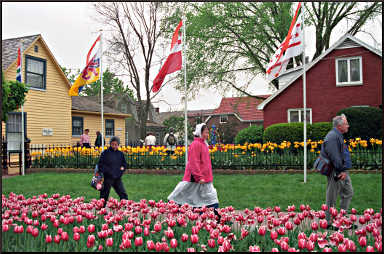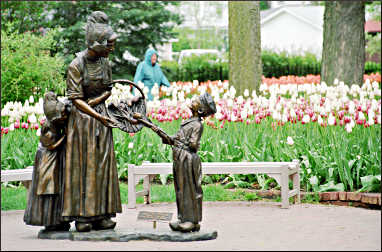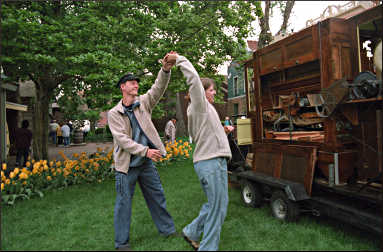Tulip Time in Pella
In central Iowa, the Dutch celebrate colorful origins.

© Beth Gauper
Even in a region rich in ethnicity, the Dutch stand out.
In a town square in Iowa, lacy white hats shaped like pyramids, horns and half-moons bob high atop women's heads. Men wear black caps, breeches or baggy trousers and narrow bands cross at their throats. Their wooden shoes click and clack as they dance.
"These are the weirdest people I've ever seen!" shrieked a little boy watching from the sidelines.
But the Dutch Family Singers aren't a bit unusual in Pella, where descendants of the town's early settlers pay homage to their forebears, especially during Tulip Time in May.
Rosemary Salzman, of Wild Rose, Wis., had come to the festival dressed like a matron from North Brabant, the Dutch province from which her grandmother came.
She'd worked four months on the flowing black dress and white poeffer, a bulky lace hat that flops over the ears like bicycle panniers and is tied over a bonnet.
"I can't wait to send the pictures to Dad," she said with a giggle. "He'll die, he'll love it so much; I'll look like his ma."
During Tulip Time, the central Iowa town of Pella shows off the greatest hits of Dutch culture, with acres of tulips, yards of lace and as many chocolates, cheeses and almond Dutch letters as anyone can eat.
Dancers in wooden shoes entertain the crowd, and the Tulip Queen and her court parade down a Franklin Street newly cleaned by costumed scrubbers with wooden buckets and brushes.
It would've been a bit much for the first residents, who came to Pella in 1847 because they thought the state church in Holland too lax, too modern and theologically unsound.
A somber group, they once complained to the town's founder, Dominie, or Reverend, Hendrik Pieter Scholte, that his wife was too beautiful and too elegant to be a pastor's wife.

© Beth Gauper
Even Sinter Klaas, the Dutch Santa, was suspect. But the bearded Sinter Klaas appears at Tulip Time with his galleon and his horse, which he rides across the rooftops each December.
"This is not part of the town tradition; it's just part of this event," said Jay deYoung, who was wearing Sinter Klaas' tall red miter. "This town was so Calvinistic, they thought gift-giving was sinful. But over 150 years, they've lightened up."
With more than 100,000 tourists coming each year, the town has to show some sparkle. Gardeners plant 80,000 tulip bulbs each fall. Residents spend months sewing costumes, each representing a different province in Holland. Candy makers pour and wrap chocolate tulips.
Bakers twist thousands of Dutch letters, an almond-filled puff pastry that's most often S-shaped. In the bakery of the Pella Historical Village, Durl Schletzbaum alone makes 960.
"You have to cool the dough four times," he said, rolling and buttering the letters. "It's a lot of work."
So when the tourists come, they're properly dazzled. In the gardens of the Scholte home, people from all over the world pose with "The Gardener," in which a bronze boy presents a mother and her shy daughter with a bundle of tulips.
Inside the 22-room house, which has been a tourist attraction ever since it was finished in 1848, they see the iron chest that carried enough gold to buy 18,000 acres.
In the Dominie's study — he spoke four languages and named the town for a Jordanian town mentioned in the Old Testament as a "city of refuge" — there's the original town plat, showing avenues named Perseverance, Reformation, Gratitude and Patience.
In the drawing room, there's one Delft plate, all that remained of Mareah Scholte's dishes after the voyage from Holland; the fragments were used to make a little path between the house and the log cabin in which they first lived.
Her piano also is in the room, and her art.
Mareah, educated in Paris, never took to pioneer life; among her last words were, "I am dying a stranger in a strange land."

© Beth Gauper
The peasant culture is represented everywhere else. In a workshop at the Pella Historical Village, guest shoemaker Lute van de Bult was shaping wooden shoes, or Klompen, which he still wears around his home in the Netherlands.
"When I wear them in the city," he said, "people look at me — 'What is he doing?' But in my village, it is no problem." The shoes, made because people couldn't afford leather, now are worn mostly in the garden, he added.
The historical village is an utterly charming theme park of folk life. Brick paths lined with tulip beds connect the 21 buildings, among them a working smithy, a working grist mill and the boyhood home of Wyatt Earp.
Brightly painted carts are parked on the grass, each selling something different — Bloemen, Worstjes, Melk.
Costumed "vendors" wheel them out daily to join the parades, one in the afternoon and one at night.
On the streets, there are long lines for the Kiwanis' poffertjes, or "small hats," pancakes served with hot butter and powdered sugar. On the brick Klokkenspel, eight 4-foot figures, including Mareah and Dominie Scholte, twirl to the bells of a carillon.
On a side street, Sinter Klaas is getting his photo taken with Japanese tourists. "Don't forget to be good, or you'll get rocks in your shoe," he calls.
There's a windmill downtown, in Central Park, and another three blocks away, in Sunken Gardens Park. In West Market Park, there's a daily re-enactment of a Dutch cheese market during Tulip Time.
There's even a canal, with lampposts and a drawbridge. It's part of the Molengracht — in Dutch, mill canal — a brick complex of shops, condos and hotel.
That's a whole lot of Dutchness for a town of only 10,000.
Today, Pella is a prosperous town with two world-class manufacturing firms, Pella and Vermeer, and it doesn't particularly need tourism. The trademarks of the old culture — the shoes made of wood, the dresses dyed black so they wouldn't show dirt — haven't been needed for a long time.

© Beth Gauper
Even so, it's a heritage much too colorful to give up.
Trip Tips: Tulip Time in Pella, Iowa
Getting there: Pella is 40 miles southeast of Des Moines.
Tulip Time: It's held the first Thursday-Saturday of May.
Accommodations: The brick Amsterdam Hotel on the Molengracht has 38 rooms and suites.
For Tulip Time, book a year in advance. Late-comers may have to stay in Des Moines.
Other events: Kermis, a Dutch summer festival, is the first Saturday in July. Fall Festival at the Historical Village is the fourth weekend of September.
Recreation: The paved, 13-mile Volksweg Trail connects Pella to Lake Red Rock, Iowa's largest lake.
Information: Pella tourism, 888-746-3882.